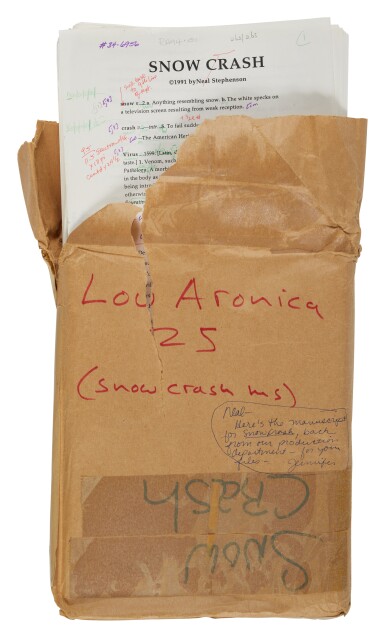
Neal Stephenson
The original typesetting manuscript for "Snow Crash," ca. 1992.
Lot Closed
March 6, 07:04 PM GMT
Estimate
20,000 - 30,000 USD
Lot Details
Description
Typed Manuscript, [i-vi] + 1-516 pp., printed rectos only, with extensive autograph notations, revisions, and substantive changes on recto and verso throughout, various hands in multiple inks and pencil (red ballpoint, blue ballpoint, black ballpoint, purple felt tip, blue felt tip, green pencil), copious autograph notations in Neal Stephenson’s hand in blue felt tip pen, two printed illustrations on pages numbered 233 and 281 as indicated in top right corner of manuscript, including paperboard back cover with grey muslin drawstring attached, original brown kraft paper wrappers reading, “Lou Aronica (Snow Crash ms)” in red marker, “Snow Crash” upside down in blue marker, circled note in blue ballpoint reading, “Neal-/Here’s the manuscript for Snow Crash, back from our production department – for your files – Jennifer.”
THE ORIGINAL REVISED TYPESETTING MANUSCRIPT FOR SNOW CRASH, WITH NEAL STEPHENSON’S ABUNDANT NOTATIONS, REVISIONS, AND CHANGES ALONGSIDE THOSE OF HIS EDITORS
“When the computer crashed and wrote gibberish into the bitmap, the result was something that looked vaguely like static on a broken television set – a “snow crash.” Neal Stephenson, In the Beginning…was the Command Line, p. 21.
Neal Stephenson’s Snow Crash is considered, along with William Gibson’s Neuromancer, one of the pillars of the cyberpunk genre and one of the most important works of modern science fiction. Edited by Jennifer Hershey on famed sci-fi editor Lou Aronica’s team at Bantam Spectra, Stephenson’s vision of a hyper-capitalist, post-national, arch-libertarian future might be fiction, but it anticipated – and in many ways served as the source code for – much of our contemporary world, from the metaverse to cryptocurrency, mobile computing to augmented reality, and much more.
The plot of the book focuses on the aptly named Hiro Protagonist, a katana-wielding computer hacker working as the “Deliverator” – i.e., a pizza delivery guy – who stumbles upon a plot to distribute the drug/virus/religion "Snow Crash" to every individual in both the real world and the Metaverse. Aided by a “Kourier” named Yours Truly, or Y.T. – the original character from the Dioxin Posse graphic novel – the duo work to take down the distributor of Snow Crash, the communications magnate and religious cult leader L. Bob Rife, and the assassin in his employ, the murderous and bloodthirsty Raven.
A major theme woven throughout the book is the power of communication and the various media through which communication can be achieved. For example, the Snow Crash virus can be acquired as an informational virus through the Metaverse, or as a biological virus carried by the blood of the infected. The type of communication that the Snow Crash virus enables – top-down and for the purposes of control – is contrasted with the Metaverse, which has the potential to allow for the free exchange of information and shared experience between millions and millions of people. Stephenson’s work demonstrates that communication as a tool is neither good nor bad: it is how it is structured and the messages it conveys that determines its value.
Switching between the Metaverse and Reality, in a style that seamlessly blends fiction and reality, Stephenson’s novel exemplifies the concept of “hyperreality” as expounded upon by French philosopher Jean Baudrillard. As in Baudrillard’s theory, the Metaverse that Stephenson depicts in Snow Crash is an immersive world that is every bit as ‘real’ as Reality, and yet it is a simulation that does not correspond to anything in the real world. As such, it can seduce and enthrall its users with features that would not be possible outside of the virtual realm.
Similarly, one sees echoes of the work of French literary theorist René Girard in Snow Crash. Stephenson’s discussion of the ways in which the Snow Crash virus exploits humanity’s deep neural pathways and the fundamental structures of communication – much like ancient Sumerian religion – to hijack the minds of unsuspecting individuals, is redolent of Girard’s work on imitation and mimesis as the origin of society and language. Indeed, both Girard’s project and Snow Crash can be said to have the same goal: the understanding of the role of mythologies – be they religious, national, technological, or otherwise – in generating our experience of the world and our shared human desires.
